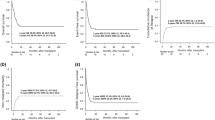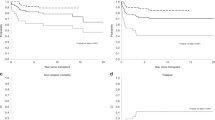Summary:
To determine the outcome of patients with chemosensitive relapsed or primary refractory Hodgkin's disease (HD) or aggressive non-Hodgkin's lymphoma (NHL) whose disease progresses after autologous stem cell transplantation (ASCT), we reviewed the records of 82 patients with HD and 139 patients with NHL transplanted between 1993 and 2000. Disease progression occurred in 25 patients with HD and 66 patients with NHL, with median times to progression (TTP) of 3.8 and 5.1 months, respectively. Median survival times following ASCT failure were 26 and 7.7 months for patients with HD and NHL, respectively. The second-line international prognostic index (sIPI) and the TTP (before or after 3 months from ASCT) independently were predictive of survival for NHL patients. In addition, treatment with rituximab for patients with B cell NHL was associated with improved survival (median 28.6 vs 4.1 months, P=0.003), independent of the sIPI and TTP. Prognostic factors for patients with HD were not identified. Only two patients, one of whom was among six patients who received second autologous transplants, remain disease-free. The uniformly poor outcome associated with disease progression after ASCT should prompt efforts to assess the feasibility and utility of detecting and treating post transplant residual disease during a minimal disease state, before overt progression.
This is a preview of subscription content, access via your institution
Access options
Subscribe to this journal
Receive 12 print issues and online access
$259.00 per year
only $21.58 per issue
Buy this article
- Purchase on Springer Link
- Instant access to full article PDF
Prices may be subject to local taxes which are calculated during checkout



Similar content being viewed by others
References
Philip T, Guglielmi C, Hagenbeek A et al. Autologous bone marrow transplantation as compared with salvage chemotherapy in relapses of chemotherapy-sensitive non-Hodgkin's lymphoma. N Engl J Med 1995; 333: 1540–1545.
Kewalramani T, Zelenetz AD, Hedrick EE et al. High-dose chemoradiotherapy and autologous stem cell transplantation for patients with primary refractory aggressive non-Hodgkin lymphoma: an intention-to-treat analysis. Blood 2000; 96: 2399–2404.
Vose JM, Zhang MJ, Rowlings PA et al. Autologous transplantation for diffuse aggressive non-Hodgkin's lymphoma in patients never achieving remission: a report from the Autologous Blood and Marrow Transplant Registry. J Clin Oncol 2001; 19: 406–413.
Linch DC, Winfield D, Goldstone AH et al. Dose intensification with autologous bone-marrow transplantation in relapsed and resistant Hodgkin's disease: results of a BNLI randomised trial. Lancet 1993; 341: 1051–1054.
Schmitz N, Pfistner B, Sextro M et al. Aggressive conventional chemotherapy compared with high-dose chemotherapy with autologous haemopoietic stem-cell transplantation for relapsed chemosensitive Hodgkin's disease: a randomised trial. Lancet 2002; 359: 2065–2071.
Vose JM, Bierman PJ, Anderson JR et al. Progressive disease after high-dose therapy and autologous transplantation for lymphoid malignancy: clinical course and patient follow-up. Blood 1992; 80: 2142–2148.
Shamash J, Lee SM, Radford JA et al. Patterns of relapse and subsequent management following high-dose chemotherapy with autologous haematopoietic support in relapsed or refractory Hodgkin's lymphoma: a two centre study. Ann Oncol 2000; 11: 715–719.
Moskowitz CH, Nimer SD, Zelenetz AD et al. A 2-step comprehensive high-dose chemoradiotherapy second-line program for relapsed and refractory Hodgkin disease: analysis by intent to treat and development of a prognostic model. Blood 2001; 97: 616–623.
Moskowitz CH, Bertino JR, Glassman JR et al. Ifosfamide, carboplatin, and etoposide: a highly effective cytoreduction and peripheral-blood progenitor-cell mobilization regimen for transplant-eligible patients with non-Hodgkin's lymphoma. J Clin Oncol 1999; 17: 3776–3785.
Kaplan E, Meier P . Nonparametric estimation from incomplete observations. J Am Stat Assoc 1958; 53: 457–481.
Mantel N . Evaluation of survival data and two new rank order statistics arising in its consideration. Cancer Chemother Rep 1966; 50: 163–170.
Cox D . Regression models and life-tables. J Roy Stat Soc [B] 1972; 34: 187–220.
Rosner B Hypothesis Testing: Categorical data. Fundamentals of Biostatistics. Wadsworth: Belmont, CA 1994, pp 345–442.
Hasenclever D, Diehl V . A prognostic score for advanced Hodgkin's disease. International Prognostic Factors Project on Advanced Hodgkin's Disease. N Engl J Med 1998; 339: 1506–1514.
Bierman PJ, Lynch JC, Bociek RG et al. The International Prognostic Factors Project score for advanced Hodgkin's disease is useful for predicting outcome of autologous hematopoietic stem cell transplantation. Ann Oncol 2002; 13: 1370–1377.
Moskowitz CH, Nimer SD, Glassman JR et al. The International Prognostic Index predicts for outcome following autologous stem cell transplantation in patients with relapsed and primary refractory intermediate-grade lymphoma. Bone Marrow Transplant 1999; 23: 561–567.
Crump M, Smith AM, Brandwein J et al. High-dose etoposide and melphalan, and autologous bone marrow transplantation for patients with advanced Hodgkin's disease: importance of disease status at transplant. J Clin Oncol 1993; 11: 704–711.
Lancet JE, Rapoport AP, Brasacchio R et al. Autotransplantation for relapsed or refractory Hodgkin's disease: long-term follow-up and analysis of prognostic factors. Bone Marrow Transplant 1998; 22: 265–271.
Rodriguez J, Rodriguez MA, Fayad L et al. ASHAP: a regimen for cytoreduction of refractory or recurrent Hodgkin's disease. Blood 1999; 93: 3632–3636.
Philip T, Armitage JO, Spitzer G et al. High-dose therapy and autologous bone marrow transplantation after failure of conventional chemotherapy in adults with intermediate-grade or high-grade non-Hodgkin's lymphoma. N Engl J Med 1987; 316: 1493–1498.
Yuen AR, Rosenberg SA, Hoppe RT et al. Comparison between conventional salvage therapy and high-dose therapy with autografting for recurrent or refractory Hodgkin's disease. Blood 1997; 89: 814–822.
Bolwell BJ, Kalaycio M, Goormastic M et al. Progressive disease after ABMT for Hodgkin's disease. Bone Marrow Transplant 1997; 20: 761–765.
Argiris A, Seropian S, Cooper DL . High-dose BEAM chemotherapy with autologous peripheral blood progenitor-cell transplantation for unselected patients with primary refractory or relapsed Hodgkin's disease. Ann Oncol 2000; 11: 665–672.
Bolwell B, Goormastic M, Andresen S . Durability of remission after ABMT for NHL: the importance of the 2-year evaluation point. Bone Marrow Transplant 1997; 19: 443–448.
Bierman P, Vose J, Lynch J et al. Late relapses following autologous hematopoietic stem cell (ASCT) transplantation for non-Hodgkin's lymphoma (NHL). Blood 1999; 94: 610a.
Alizadeh AA, Eisen MB, Davis RE et al. Distinct types of diffuse large B-cell lymphoma identified by gene expression profiling. Nature 2000; 403: 503–511.
Shipp MA . Diffuse large B-cell lymphoma outcome prediction by gene-expression profiling and supervised machine learning. Nat Med 2002; 8: 68–74.
Prince HM, Imrie K, Crump M et al. The role of intensive therapy and autologous blood and marrow transplantation for chemotherapy-sensitive relapsed and primary refractory non-Hodgkin's lymphoma: identification of major prognostic groups. Br J Haematol 1996; 92: 880–889.
Horwitz SM, Negrin RS, E S-GK et al. Phase II trial of rituximab as adjuvant therapy to high dose chemotherapy and peripheral blood stem cell transplantation for relapsed and refractory aggressive non-Hodgkin's lymphoma. Blood 2001; 98: 862a.
McLaughlin P, Grillo-Lopez AJ, Link BK et al. Rituximab chimeric anti-CD20 monoclonal antibody therapy for relapsed indolent lymphoma: half of patients respond to a four-dose treatment program. J Clin Oncol 1998; 16: 2825–2833.
Maloney DG, Smith B, Rose A . Rituximab: mechanism of action and resistance. Sem Oncol 2002; 1(Suppl. 2): 2–9.
Clynes RA . Inhibitory Fc receptors modulate in vivo cytoxicity against tumor targets. Nat Med 2000; 6: 443–446.
Porrata LF . Immune reconstitution after autologous hematopoietic stem cell transplantation. Mayo Clinic Proc 2001; 76: 407–412.
Tsai D . Rituximab (anti-CD20 monoclonal antibody) therapy for progressive intermediate-grade non-Hodgkin's lymphoma after high-dose therapy and autologous peripheral stem cell transplantation. Bone Marrow Transplant 1999; 24: 521–526.
Pan D, Moskowitz CH, Zelenetz AD et al. Rituximab for aggressive non-Hodgkin's lymphomas relapsing after or refractory to autologous stem cell transplantation. Cancer J 2002; 8: 371–376.
de Lima M, van Besien KW, Giralt SA et al. Bone marrow transplantation after failure of autologous transplant for non-Hodgkin's lymphoma. Bone Marrow Transplant 1997; 19: 121–127.
Tsai T, Goodman S, Saez R et al. Allogeneic bone marrow transplantation in patients who relapse after autologous transplantation. Bone Marrow Transplant 1997; 20: 859–863.
Bierman P, Kottaridis P, Kollath J et al. Allogeneic transplantation following failure of autologous transplantation for lymphoma. Blood 1998; 92: 321a.
Wong C, Hahn T, Moysich K et al. Allogeneic and autologous blood or marrow transplantation (BMT) for Hodgkin disease: comparison of survival, longterm effect and lack of efficacy of allogeneic BMT following failed autologous BMT. Blood 1999; 94: 169a.
Radich JP, Gooley T, Sanders JE, Anasetti C, Chauncey T, Appelbaum FR . Second allogeneic transplantation after failure of first autologous transplantation. Biol Blood Marrow Transplant 2000; 6: 272–279.
Press OW, Eary JF, Gooley T et al. A phase I/II trial of iodine-131-tositumomab (anti-CD20), etoposide, cyclophosphamide, and autologous stem cell transplantation for relapsed B-cell lymphomas. Blood 2000; 96: 2934–2942.
Nagler A, Or R, Naparstek E, Varadi G, Slavin S . Second allogeneic stem cell transplantation using nonmyeloablative conditioning for patients who relapsed or developed secondary malignancies following autologous transplantation. Exp Hematol 2000; 28: 1096–1104.
Dey BR, McAfee S, Sackstein R et al. Successful allogeneic stem cell transplantation with nonmyeloablative conditioning in patients with relapsed hematologic malignancy following autologous stem cell transplantation. Biol Blood Marrow Transplant 2001; 7: 604–612.
Feinstein LC, Sandmaier BM, Maloney DG et al. Non-myeloablative allogeneic transplantation as a treatment for relapsed hematologic malignancy after a failed conventional autologous or allogeneic transplant. Blood 2001; 98: 855a.
Vose JM, Bierman PJ, Anderson JR et al. Single-photon emission computed tomography gallium imaging versus computed tomography: predictive value in patients undergoing high-dose chemotherapy and autologous stem-cell transplantation for non-Hodgkin's lymphoma. J Clin Oncol 1996; 14: 2473–2479.
Gribben JG, Neuberg D, Freedman AS et al. Detection by polymerase chain reaction of residual cells with the bcl-2 translocation is associated with increased risk of relapse after autologous bone marrow transplantation for B-cell lymphoma. Blood 1993; 81: 3449–3457.
Hardingham JE, Kotasek D, Sage RE et al. Significance of molecular marker-positive cells after autologous peripheral-blood stem-cell transplantation for non-Hodgkin's lymphoma. J Clin Oncol 1995; 13: 1073–1079.
Acknowledgements
We are indebted to Drs Daniel Filippa, Julie Feldstein, and Diane Louie for their meticulous review of the pathology specimens. Supported in part by the Mortimer Lacher Fund, the Dewitt Wallace Fund, and Grant No. 5P01CA5826-34 from the National Institutes of Health, Bethesda, MD. TK was a Mortimer J. Lacher Fellow
Author information
Authors and Affiliations
Corresponding author
Rights and permissions
About this article
Cite this article
Kewalramani, T., Nimer, S., Zelenetz, A. et al. Progressive disease following autologous transplantation in patients with chemosensitive relapsed or primary refractory Hodgkin's disease or aggressive non-Hodgkin's lymphoma. Bone Marrow Transplant 32, 673–679 (2003). https://doi.org/10.1038/sj.bmt.1704214
Received:
Accepted:
Published:
Issue Date:
DOI: https://doi.org/10.1038/sj.bmt.1704214
Keywords
This article is cited by
-
Improved survival of autologous stem cell transplantation in primary refractory and relapsed Hodgkin lymphoma in the brentuximab vedotin era — real-world data from Hungary
Annals of Hematology (2023)
-
Real-World Healthcare Resource Utilization in Patients with Classical Hodgkin Lymphoma Treated with Pembrolizumab and Nivolumab in the USA
Targeted Oncology (2021)
-
Improving outcomes after autologous transplantation in relapsed/refractory Hodgkin lymphoma: a European expert perspective
BMC Cancer (2020)
-
Prognostic factors and long-term outcome of autologous haematopoietic stem cell transplantation following a uniform-modified BEAM-conditioning regimen for patients with refractory or relapsed Hodgkin lymphoma: a single-center experience
Medical Oncology (2013)
-
Constitutively overexpressed 21 kDa protein in Hodgkin lymphoma and aggressive non-Hodgkin lymphomas identified as cytochrome B5b (CYB5B)
Molecular Cancer (2010)



